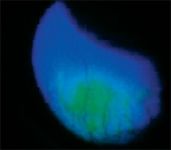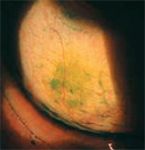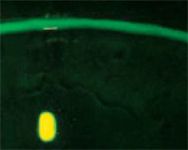Article
Dye aids ocular surface exam
A proprietary fluorescein sodium and lissamine green dye combination has shown favorable results for evaluating the ocular surface.

For Paul S. Koch, MD, one drop of the dye formulation permits the examiner to evaluate all necessary components of the surface eye examination-that is, conjunctival staining, corneal staining, and tear film break-up time-quickly and simultaneously.
Dr. Koch, in private practice in Warwick, RI, added that an important development that occurred as a direct result of the increasing popularity of refractive surgery is a better understanding of ocular surface disease and how it affects the patient's quality of vision.
"Therefore, it is recommended that the surface tear layer be evaluated before refractive surgery and also in response to a patient's subjective complaints of poor quality of vision," Dr. Koch said. "Unfortunately, the methods we have used up until now have had limitations and we have needed a simpler and more effective way to perform the evaluation."
Fluorescein applied to the ocular surface is the best way to measure the tear film break-up time, which indicates if there is disruption of the tears on the surface, Dr. Koch said. Fluorescein can be applied as an eye drop or as a drop from a moistened dye-impregnated strip. Both methods are adequate to measure the tear film break-up time, although the strip has an inconsistent volume of dye.
Fluorescein also can be used to detect evidence of epithelial disruption, and the test is limited in that the volume and distribution of the dye varies when a moistened strip is used.

"This dye is likely the most sensitive and precise method we have for evaluating the health of the surface cells," he said. "It is usually applied from a moistened strip, and the variations in volume and concentration inherent in that delivery system limit its usefulness."
Combination product

Dr. Koch described why he likes this drop.

"In addition, the concentrations in [this dye combination formulation] are optimized for best visualization," Dr. Koch said. "Staining was immediately visible and obvious and did not require a detailed study, because the findings jumped out at me. [The dye combination] represents a significant development that will let us perform studies of the ocular surface more frequently, more consistently, and with easier observation."

"It's much easier to tell a patient there is a surface problem that needs to be addressed before surgery than it is to try to explain to them afterwards that the surgery did not cause the problem they are having," he said. "[The dye combination] improves our ability to evaluate all candidates efficiently for premium lens implantation and refractive surgery preoperatively to detect ocular surface disease before surgery.
"This helps each patient obtain the anticipated premium experience," he added. "It is always a disappointment when a patient has a suboptimal result because the surgeon did not recognize early signs of ocular surface disease."
For other patients who have problems with quality of vision, applying one drop of the dye combination facilitates the surface evaluation to determine the presence of an ocular surface disease and if so, which type. This eliminates the need to try artificial tears in the hope that the ocular surface will improve and allows the surgeon to recommend a treatment that specifically treats the problem at hand.





